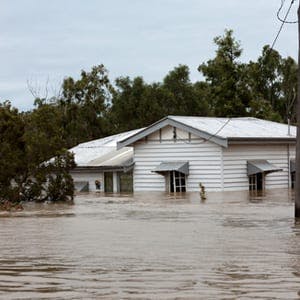While the floodwaters continue to rise in some parts of the country, for others it’s time to look at the damage they’ve caused. If your business has been affected by floods, here’s what to do.
The remains of ex tropical cyclone Oswald have caused havoc in Queensland and NSW over the long weekend, causing widespread flooding around southern Queensland, Brisbane and northern NSW.
Flood warnings were still current at time of writing for the lower Brisbane and Bremer Rivers, Lockyer and Laidleys Creeks. Flood warnings were also current for NSW’s Clarence Valley.
The Queensland Government’s Business portal website has posted information about coping with a natural disaster, which small businesses in the state should read. It includes information on how to contact your insurer, cleaning up and assessing the future of your business.
NSW Small Business Commissioner Yasmin King, offered the following advice for any NSW businesses that have been affected.
“For all small business owners and operators affected by the floods, the safety and care of you and your family is the most important thing at this time. Please take note of the advice provided by Emergency Services and ensure that when you return to your business, you are not in a situation where you or others are at risk.
At times of distress like this, it is important to have a plan – identify those things which are critical for the re-starting of your business operations and prioritise these, one by one.
Seek out the disaster relief which is available through NSW Emergency Services, the NSW Rural Assistance Authority, NSW Department of Primary Industries and visit www.disasterassist.gov.au. If you have a loan with a bank, contact the bank to see how they can assist you at this time.
From a business perspective, if you need practical and constructive advice about getting your business back on track, get in touch with your local Small Biz Connect advisor by calling 1300 795 534 or visiting www.smallbusiness.nsw.gov.au/smallbiz-connect.”
The Federal Government has responded to the floods by offering assistance to flood-affected communities through the Natural Disaster Relief and Recovery Arrangements (NDRRA)
“As ex-Tropical Cyclone Oswald continues to track south, more communities are being affected by damaging winds, heavy rainfall and flooding,” said Acting Commonwealth Attorney-General and Minister for Emergency Management Jason Clare.
“It is important that disaster assistance is extended to these communities.”
Queensland Minister for Police and Community Safety, Jack Dempsey announced that 25 councils were eligible for various forms of assistance.
“This assistance under the NDRRA includes personal hardship and distress payments to individuals, counter disaster operations and means essential community assets can be repaired.”
These floods come only two years after the 2010/2011 Queensland floods that killed 35 people and devastated large parts of the state.
While most insurance policies will cover storm damage, which is most of the damage caused by the cyclone, rising river flooding if you’re on a flood plain is a different form of cover and you need to check that that’s included in your policy if that’s the damage that has affected your business. John Argent from GIO Business Insurance offers the following advice:
“If your business has been damaged by a storm, a few simple steps will make working through your insurance claim a lot easier:
Photos photos photos – take pictures of the damage as this can be used by your insurer to support your claim.
If you have to dispose of things that are a hygiene or health and safety risk, make a list of the items and take photos. Saturated carpets can be removed and thrown out, but keep a small sample (about 30cm square) so your insurance company can replace it with something equivalent.
It is preferable that items such as damaged machinery are inspected by the insurance assessor, so if possible, store these things until the assessor arrives. It will help your claim to be processed more quickly.
Lodgement – Call your insurance company as soon as you can, but if there’s been a large storm there will be a wait. You do not need to have your policy number to lodge a claim, but it will make the process slightly quicker.”

